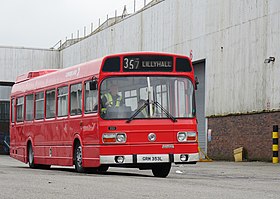| Leyland National | |
|---|---|
 Preserved NBC Cumberland Leyland National, the earliest surviving National produced, outside the former British Leyland Lillyhall factory in May 2022 | |
| Overview | |
| Manufacturer | Leyland |
| Production | 1972–1985 |
| Assembly | Workington, Cumbria, England |
| Designer | Giovanni Michelotti[1] |
| Body and chassis | |
| Doors | 1, 2 or 3 |
| Floor type | Step entrance |
| Chassis | Integral |
| Powertrain | |
| Engine | |
| Transmission | |
| Dimensions | |
| Length | 10.3 m (34 ft), 10.6 m (35 ft), 10.9 m (36 ft), 11.3 m (37 ft), 11.6 m (38 ft) |
| Chronology | |
| Predecessor | |
| Successor | Leyland Lynx |
The Leyland National is an integrally-constructed British step-floor single-decker bus manufactured in large quantities between 1972 and 1985. It was developed as a joint project between two UK nationalised industries – the National Bus Company and British Leyland.[2] Buses were constructed at a specially built factory at the Lillyhall Industrial Estate, Workington. Styling was carried out by the Italian vehicle stylist Giovanni Michelotti, previously commissioned by both Triumph (Herald, TR4, GT6, 2000/2500, 1300, Dolomite and Stag) and Scammell lorries (Routeman GRP cab).
It was intended to replace all the rear-engined single-decker buses offered by British Leyland, including the AEC Swift, Bristol RE, single-deck Daimler Fleetline, Daimler Roadliner and Leyland Panther.
- ^ Jack, Doug (1984). "1970: The Leyland National". The Leyland Bus Mk 2. Glossop: Transport Publishing Company. pp. 378–405. ISBN 1 85648 103 4.
- ^ Moses, Derek (18 July 1969). "Enter Leyland National with an integral bus". Commercial Motor. Retrieved 5 February 2020.
